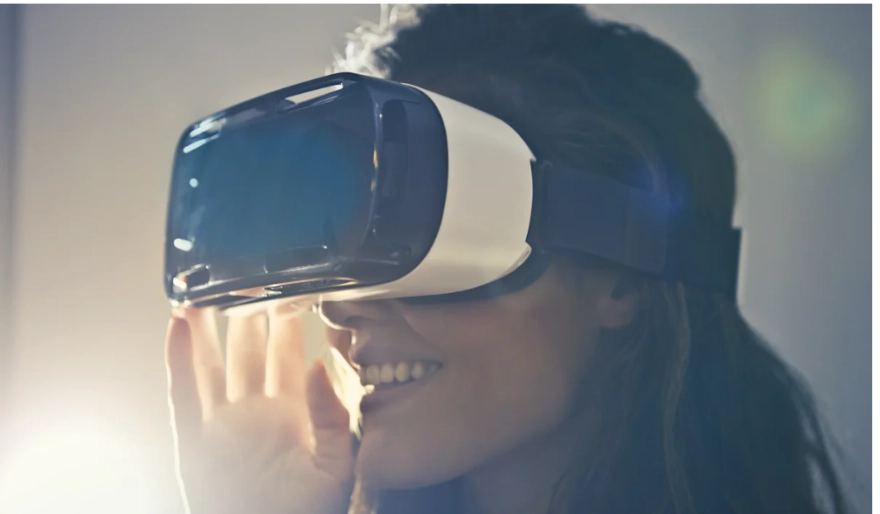How augmented reality is reshaping everyday mobile apps
39 min read You might wonder why augmented reality has become a must-have feature in mobile apps. The answer lies in its ability to transform how you interact with digital content.written by Sophia Reynolds, Content Creator June 22, 2024 16:03
Image Source: pexels
Augmented reality is changing how you interact with mobile apps. It blends digital elements into your physical surroundings, creating a seamless and engaging experience. Over 83 million people in the United States use AR monthly, and its market value is expected to reach $136.55 billion by 2025. Industries like retail, healthcare, and education have embraced AR to enhance app functionality. For example, you can try on clothes virtually, explore 3D learning models, or even take a virtual property tour. This technology is not just a trend; it is shaping the future of mobile apps.
Key Takeaways
- Augmented reality (AR) makes apps fun by mixing digital with real life.
- AR helps shopping by letting users try items virtually. This boosts buying confidence and lowers returns.
- In schools, AR makes learning fun and easier to remember. It helps students understand lessons better.
- AR navigation apps show directions on real-world views, making travel simple.
- The future of AR includes smart AI and wearable gadgets. These will make AR more useful and personal every day.
Understanding Augmented Reality in Mobile Apps
What is Augmented Reality?
Augmented reality brings digital elements into your physical world, creating an interactive experience through your mobile device. Unlike virtual reality, which immerses you in a completely simulated environment, augmented reality enhances your surroundings by overlaying digital content in real time. For example, AR apps can display 3D objects, animations, or information on your phone screen while you view your actual environment. This technology doesn’t require specialized hardware like VR headsets, making it more accessible and practical for everyday use.
Why AR is Essential for Mobile Apps
You might wonder why augmented reality has become a must-have feature in mobile apps. The answer lies in its ability to transform how you interact with digital content.
- Improved User Engagement: AR encourages you to explore apps in new ways, making your experience more enjoyable and memorable.
- Enhanced Shopping Experience: E-commerce apps let you visualize products in your space, helping you make confident purchasing decisions.
- Interactive Learning and Training: AR makes lessons more engaging by adding practical, hands-on elements to education and skill development.
These benefits explain why industries like retail, education, and healthcare are rapidly adopting AR to improve their apps.
How AR Enhances User Interaction
Augmented reality takes user interaction to the next level by blending the digital and physical worlds. In retail, you can try on clothes, glasses, or makeup virtually, saving time and effort. Gaming apps like Pokémon GO use AR to create immersive experiences by integrating virtual characters into your surroundings. In education, AR apps provide interactive 3D models that make learning more engaging and effective.
Healthcare apps also leverage AR to improve precision and understanding. For instance, AR-assisted surgery planning helps medical professionals visualize anatomy in detail. Similarly, e-commerce apps allow you to see how furniture or décor fits into your home before buying. These examples show how AR enhances your experience by making interactions more immersive and personalized.
Everyday Applications of Augmented Reality
Social Media and Entertainment
AR Filters and Effects
Are Subscription-Based Apps Sustainable for Users and Developers?
If you’ve used apps like Snapchat, you’ve probably come across AR filters. These filters rely on real-time face tracking to apply entertaining 3D effects to selfies. They allow users to transform into cartoon characters or add virtual accessories like sunglasses. Such features enhance social media engagement, inspiring users to create and share unique content. Additionally, AR filters provide brands with interactive marketing opportunities, such as customized face filters that boost audience connection.
AR in Video and Live Streaming
Augmented reality enhances video and live streaming by adding interactive elements. Streamers can overlay virtual objects or animations during broadcasts, creating a more dynamic experience for viewers. Apps like Wanna Kicks even let you try on sneakers virtually while streaming, combining entertainment with practicality. These features make content more immersive and keep audiences engaged for longer periods.
Education and Learning
Interactive Learning Tools
AR transforms education by making learning more interactive. Imagine exploring the solar system in 3D or conducting virtual experiments safely. These tools help you visualize abstract concepts, fostering curiosity and improving understanding. Studies show that interactive AR content enhances memory retention compared to traditional methods. It also allows for personalized learning experiences tailored to your needs, making education more effective and enjoyable.
AR in Skill Development Apps
Skill development apps use AR to provide hands-on training. For example, you can practice surgical techniques or learn to repair machinery through virtual simulations. These apps create realistic scenarios, helping you gain practical experience without risks. AR also promotes collaboration by allowing multiple users to interact with shared digital content, making group learning more engaging.
Retail and E-commerce
Virtual Try-Ons
Virtual try-ons revolutionize online shopping by letting you preview products before buying. You can see how clothes, glasses, or makeup look on you without visiting a store. Retailers using AR report a 40% increase in conversion rates and a 20% rise in average order value. This technology reduces uncertainty, helping you make confident purchasing decisions and minimizing product returns.
AR for Home Design
Home design apps use AR to help you visualize renovations or furniture placement. You can customize designs in real time, ensuring they match your preferences. For instance, apps like IKEA Place let you drag and drop furniture into a 3D image of your room. This feature increases customer satisfaction and reduces the likelihood of returns. AR also facilitates communication between you and designers, making the process smoother and more efficient.
Navigation and Travel
Real-Time Directions
Augmented reality has transformed how you navigate unfamiliar places. AR-powered navigation apps overlay real-time directions onto your surroundings, making it easier to find your way. Instead of relying on traditional maps, you can follow virtual arrows or markers displayed on your phone screen. These tools detect surfaces like roads and sidewalks to place AR content accurately.
AR navigation apps also use geospatial APIs to position directions based on real-world data. This ensures that the guidance aligns perfectly with your environment. Motion tracking keeps the AR elements stable as you move, providing a seamless experience. Some apps even allow multiple users to share navigation through cloud anchors, making group travel more convenient. Whether you're walking through a busy city or driving in an unfamiliar area, AR simplifies the process and reduces confusion.
AR Travel Guides
Traveling becomes more exciting with AR travel guides. These apps blend the physical and digital worlds to create immersive experiences. You can explore landmarks virtually, learn about their history, and even interact with 3D exhibits. AR eliminates language barriers by providing on-demand translations and personalized information.
Imagine standing in front of a historic monument and pointing your phone at it. The app displays detailed facts, cultural insights, and even animations that bring the site to life. AR also superimposes directions onto your view, helping you navigate tourist spots effortlessly. This level of personalization enhances your travel experience and keeps you engaged.
With AR travel guides, you can plan your trips better and discover hidden gems. These tools make exploring new destinations more interactive, ensuring you never miss out on important details. Whether you're a solo traveler or part of a group, AR enhances your journey by combining convenience with education.
Benefits of Augmented Reality in Mobile Apps
Enhanced User Engagement
Augmented reality transforms how you interact with mobile apps, making them more engaging and memorable. AR captivates users by offering interactive experiences that go beyond traditional app interactions.
- Social media apps use AR filters to make content creation more entertaining. For example, you can add fun effects to your selfies or videos, encouraging creativity and sharing.
- AR inspires developers to design imaginative environments within apps, enhancing user behavior and making apps more appealing.
- By providing captivating encounters, AR increases the time you spend on apps and boosts overall engagement.
Tip: Apps with AR features often stand out in crowded marketplaces, attracting more users and retaining their attention longer.
Improved Learning Experiences
Augmented reality has revolutionized education by creating immersive and interactive learning environments. It allows you to visualize complex concepts and engage in hands-on activities.
- AR transforms classrooms into virtual spaces where you can manipulate objects and conduct experiments.
- Virtual field trips let you explore historical landmarks or natural wonders without leaving your home.
- Studies show that AR-assisted education leads to higher learning achievements, reduced cognitive load, and increased curiosity.
Note: AR in education not only enhances learning but also makes it more enjoyable and accessible for students of all ages.
Cost Efficiency for Businesses
Integrating augmented reality into mobile apps can save businesses significant costs while improving customer satisfaction.
- AR streamlines operations by optimizing resources and reducing inefficiencies.
- Training and simulation apps powered by AR provide realistic scenarios, eliminating the need for expensive physical setups.
- Enhanced customer engagement through AR features, such as virtual try-ons, reduces product returns and increases sales.
By adopting AR, businesses can deliver innovative solutions that attract customers and improve their bottom line. This technology not only enhances user experiences but also ensures long-term cost savings.
Immersive and Personalized Interactions
Augmented reality (AR) creates immersive and personalized experiences that transform how you interact with mobile apps. By blending digital content with your real-world environment, AR tailors app features to your preferences and surroundings. This level of customization makes apps more engaging and practical for everyday use.
How AR Delivers Immersive Experiences
AR immerses you in digital environments by overlaying interactive elements onto your surroundings. For example:
- Gaming Apps: AR games like Pokémon GO place virtual characters in your real-world setting, making gameplay more exciting.
- Fitness Apps: Virtual trainers guide you through workouts, ensuring proper form and motivation.
- Entertainment Apps: AR lets you interact with 3D characters or objects, creating a dynamic experience.
These features make you feel like part of the action, enhancing your connection with the app.
Personalization Through AR
AR apps adapt to your needs by analyzing your preferences and environment. This personalization improves usability and satisfaction. Examples include:
- Retail Apps: Virtual try-ons let you see how products look on you or in your home.
- Travel Apps: AR guides provide tailored recommendations based on your location.
- Learning Apps: Interactive lessons adjust to your skill level, ensuring effective learning.
Tip: Apps that use AR to personalize experiences often see higher user retention and satisfaction rates.
Why It Matters
Immersive and personalized interactions make apps more enjoyable and practical. They help you connect with digital content in meaningful ways, whether you're shopping, learning, or exploring. AR ensures that every interaction feels unique and tailored to your needs, setting a new standard for mobile app experiences.
Future Trends in Augmented Reality

AI Integration with AR
Artificial intelligence (AI) is transforming how you experience augmented reality. AI enhances AR apps by enabling real-time object recognition and predictive analysis. For example, an AR app can identify objects in your environment and provide relevant information instantly. This combination makes interactions smarter and more intuitive.
AI also personalizes your AR experience. It analyzes your preferences and adapts content to suit your needs. For instance, an AR shopping app can recommend products based on your past choices. This level of customization improves usability and satisfaction.
In the future, AI-driven AR will make mobile apps even more intelligent. You can expect apps that predict your needs and offer solutions before you ask. This trend will redefine how you interact with digital content.
Wearable AR Devices
Wearable AR devices, like AR glasses, are set to revolutionize mobile apps. These devices provide hands-free experiences, making AR more practical for everyday use. Imagine navigating a city with directions displayed directly in your field of view or attending a virtual meeting while walking.
Wearables expand AR applications across industries. Here’s a table showing potential uses:
These devices will make AR more accessible and versatile, allowing you to integrate it seamlessly into your daily life.
5G Advancements and AR
The rollout of 5G technology is a game-changer for augmented reality. Faster internet speeds and lower latency will enable AR apps to deliver more realistic and complex experiences. For example, you can enjoy multiplayer AR games with minimal lag or access high-quality AR content instantly.
5G also supports cloud-based AR applications. This means your device won’t need to store large files, reducing performance issues. Instead, AR content will stream directly from the cloud, ensuring smooth and immersive interactions.
As 5G networks expand, AR apps will become more powerful and efficient. You’ll see advancements in areas like telemedicine, where doctors can use AR for remote consultations, and smart homes, where AR interfaces control appliances. This combination of 5G and AR will unlock new possibilities for mobile apps.
Expanding AR in Healthcare and Fitness
Augmented reality is revolutionizing healthcare and fitness apps by offering innovative solutions that improve user experiences. This technology bridges the gap between digital tools and real-world applications, making health management and fitness routines more interactive and effective.
AR in Healthcare
AR enhances healthcare by providing tools that improve patient understanding and engagement. For example:
- 3D Visualizations: AR apps display 3D models of medical conditions, helping you understand diagnoses and treatment plans during consultations.
- Self-Diagnosis Tools: Some apps overlay information on scanned body parts, assisting you in identifying symptoms and seeking timely medical advice.
- Physical Therapy Support: AR gamifies therapy exercises, motivating you to stay consistent and complete your recovery program.
Note: These features not only improve patient outcomes but also make healthcare more accessible and user-friendly.
AR in Fitness
Fitness apps use AR to make workouts more engaging and personalized. Here’s how:
- Real-Time Feedback: Apps like Mirror overlay workout instructions on your reflection, correcting your form and ensuring safe practices.
- Fitness Games: AR integrates gameplay with physical activity, encouraging you to move more while having fun.
- Personalized Plans: Apps like Freeletics track your performance and suggest tailored fitness routines to meet your goals.
Tip: AR fitness tools keep you motivated by combining entertainment with exercise, making it easier to stick to your fitness journey.
By integrating AR, healthcare and fitness apps deliver practical, immersive, and personalized experiences. Whether you’re recovering from an injury or improving your fitness, AR empowers you to take control of your health in exciting new ways.
Augmented reality is reshaping how you interact with mobile apps, making them more engaging and practical. It inspires you to explore apps in innovative ways, from trying AR filters on social media to visualizing products in e-commerce. Apps now deliver immersive experiences, like real-time navigation or interactive learning tools, that enhance satisfaction. With AR mobile app revenue growing from $884.1 million in 2017 to $6,218.23 million in 2022, its impact is undeniable. As AR evolves, it will continue driving innovation, creating visually stunning and transformative experiences that redefine app functionality.
FAQ
What is the difference between augmented reality (AR) and virtual reality (VR)?
AR enhances your real-world environment by overlaying digital elements, while VR immerses you in a completely virtual world. AR uses your phone or tablet, but VR requires specialized headsets. AR blends the physical and digital, whereas VR replaces your surroundings entirely.
Do AR apps work on all smartphones?
Most modern smartphones support AR apps. Devices with ARKit (iOS) or ARCore (Android) compatibility offer the best experience. Check your phone’s specifications to ensure it supports AR features. Older models may not have the necessary hardware or software.
Are AR apps safe to use?
Yes, AR apps are generally safe. However, always download apps from trusted sources like official app stores. Be mindful of your surroundings while using AR to avoid accidents. Some apps may collect data, so review their privacy policies before use.
How can AR benefit small businesses?
AR helps small businesses by improving customer engagement and reducing costs. For example, virtual try-ons enhance online shopping experiences, increasing sales. AR also enables interactive marketing campaigns, attracting more customers. These tools make your business stand out in competitive markets.
What industries use AR the most?
Retail, education, healthcare, and entertainment are leading industries using AR. Retailers use it for virtual try-ons, educators for interactive lessons, and healthcare professionals for 3D visualizations. Entertainment apps like games and social media also rely heavily on AR for immersive experiences.



















